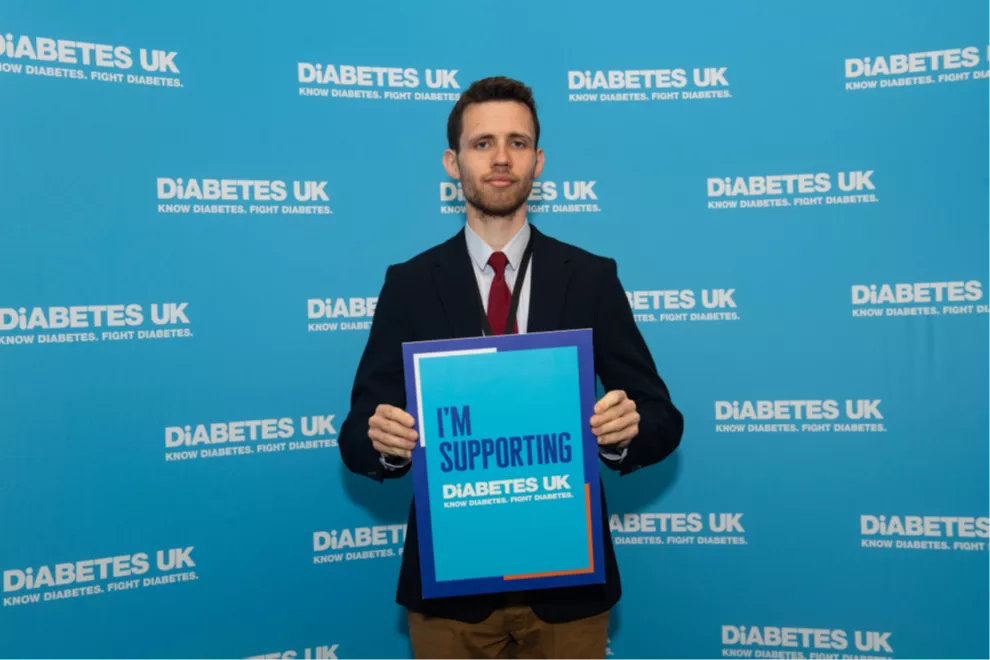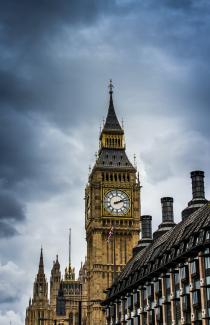
Finley is a 26-year-old and currently works as a Parliamentary Assistant for an MP in the Houses of Parliament. He shares his experience living with type 1 diabetes.

It may be a cliché, but it’s also true: having type 1 diabetes shouldn’t hold anyone back from going for whatever it is they want to achieve in life. Though diabetes is a constant, hidden battle, managed well it needn’t be a barrier. With a few blips along the way (which are to be expected), this has been my attitude since I was diagnosed with type 1, back in 2009, aged thirteen. In part, it explains why I rarely talk about having type 1. Diabetes is not something I want to be defined by, so I tend to just get on with it and focus on other matters, including one of my great passions in life, politics.
When the opportunity arose to stand for office in Pinner South at last month’s Harrow Council elections alongside my colleagues Raj Vakesan and Bill Phillips, I certainly wasn’t going to let my diabetes put me off. I did have to take extra precautions while out campaigning, though.
On the campaign trail
So much of politics on TV takes place on the green benches of the Commons, which gives the impression that it’s a largely sedentary exercise. In fact, politics involves a fair bit of physical activity, particularly on the campaign trail. In the weeks leading up to the election, I was frequently walking between 20,000 to 50,000 steps a day while leafleting, talking to hundreds of residents on the doorstep and attending community visits ‒ a significant change in my routine.
Sure enough, then, I had to reduce my insulin doses while pounding the Pinner pavements. I also made sure I ate at regular intervals, including at the brilliant Red Cup Café in North Harrow and Yaprak Kitchen in Pinner, and had dextrose tabs to hand should my blood sugar levels crash from all the leafleting exertion. Talking to a voter on the doorstep with a brain fog-inducing hypoglycemia would not have made the best impression!
The Benefits of Tech
Thankfully, I was able to reduce the number of hypos and hypers I experienced with the help of the Freestyle Libre 2, which I was prescribed on the NHS earlier this year. This nifty bit of kit has significantly improved my blood sugar control. Whereas beforehand, intermittent blood sugar checks with test strips meant that, to some extent, I was in the dark about where my blood sugars were headed, particularly overnight, I now have a much better understanding in relation to the amounts of insulin I need. The discreet alarms set up on my phone to signal a hypo or hyper, mean that I’m able to get my levels back on track quickly ‒ a lifesaver for anyone with a busy lifestyle like my own, who perhaps doesn’t have the time to frequently finger prick on the go but can quickly scan their sensor using their phone.
The centrepiece of our campaign was when Raj and I participated in Pinner’s annual wheelbarrow race, which takes place on St George’s Day every year. We rolled each other around the streets of Pinner while stopping at checkpoints to drink a half-pint of beer, amounting to roughly three pints within 10 to 15 minutes. Has any type 1 diabetic ever had to calculate the appropriate amount of insulin for such an activity in the history of diabetes? I think I may be the first!
In the end...
In the end, we didn’t win the election (or the wheelbarrow race), but among the things I was proud of on the day of the election results was the fact I had kept my blood sugar levels relatively stable during the campaign. Diabetes is as much a mental challenge as a physical one, a never-ending roller coaster of sorts, and it can be tiring to manage, let alone while fighting an election campaign. Therefore, to have achieved an unprecedented swing in my ward was something I took heart in, despite the disappointing results.
I want to see more type 1 diabetics of all parties run for elected office, be that Parliament or local government. The importance of representation, of visibility, can’t be overstated. We don’t share the same politics, but I remember feeling inspired when the then-Prime Minister Theresa May was pictured wearing a Freestyle Libre sensor in 2018. She could have avoided the endless tabloid articles by covering up her arms ‒ I wouldn’t have blamed her ‒ yet she was wearing it quite openly, which I thought was brave. If she could be Prime Minister while managing her diabetes, I thought, what was stopping me from getting more active in politics? I felt similarly when the Speaker, Sir Lindsay Hoyle, spoke out about his late type 1 diagnosis.
Though councillors don’t have direct responsibility for matters related to health, I would have liked to have raised awareness of the condition on Harrow Council, a Council that represents a borough with a higher-than-average prevalence of diabetes.
But there is more to it than simply visibility or raising awareness, particularly at the national level. Legislators have an important role to play in shaping the future of diabetes care. It would be great to have more diabetics elected to Parliament, who have direct experiences of the sorts of issues raised in Diabetes UK’s excellent report, Diabetes is Serious, the launch of which I attended in Parliament last month. In my view, bringing that lived experience to the table when it comes to policy making is incredibly valuable, and helps to ensure that diabetes remains high on the political agenda.
For these reasons, I encourage people living with diabetes to get active in politics and stand for local government and indeed Parliament, not least to champion the principle of free-at-the-point-of-use healthcare, the product of which type 1 diabetics like me have benefited from greatly since the NHS was founded in 1948.
The views and opinions expressed in the ‘views’ section of this website belong solely to the author of each article. These views and opinions do not represent those of Diabetes UK as a charity or any of its staff members.
